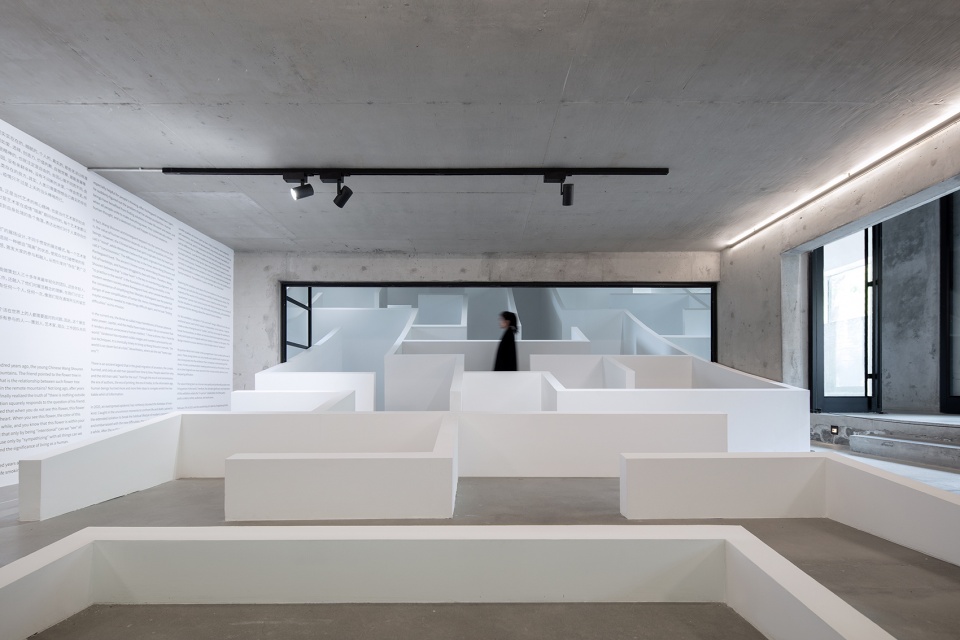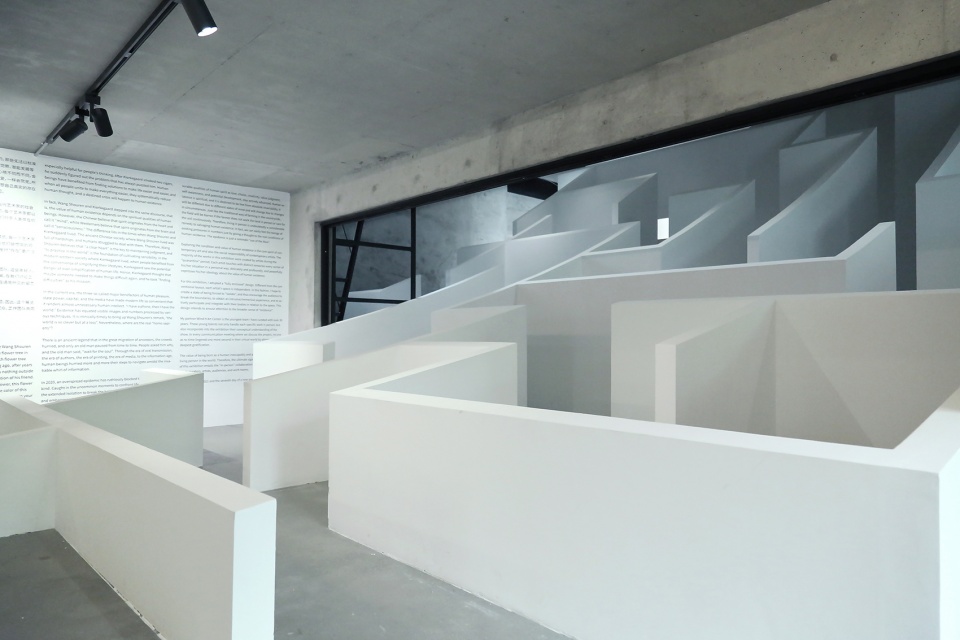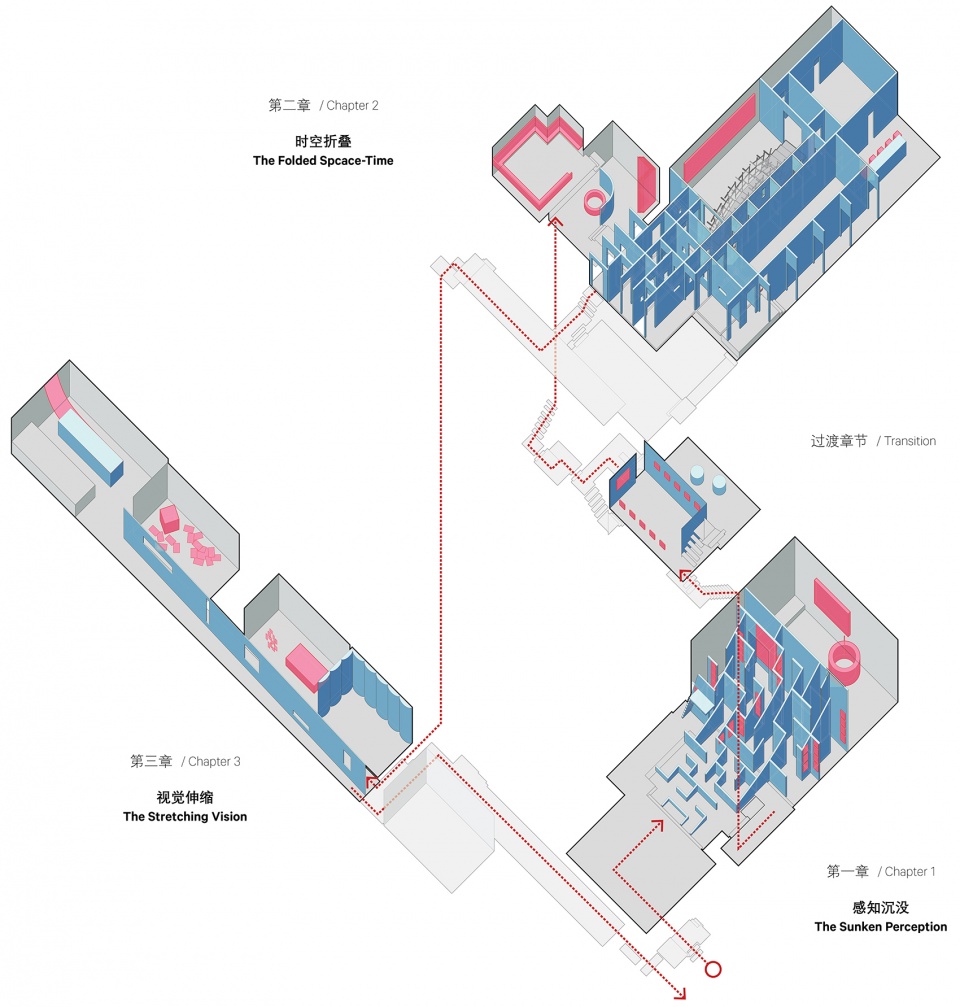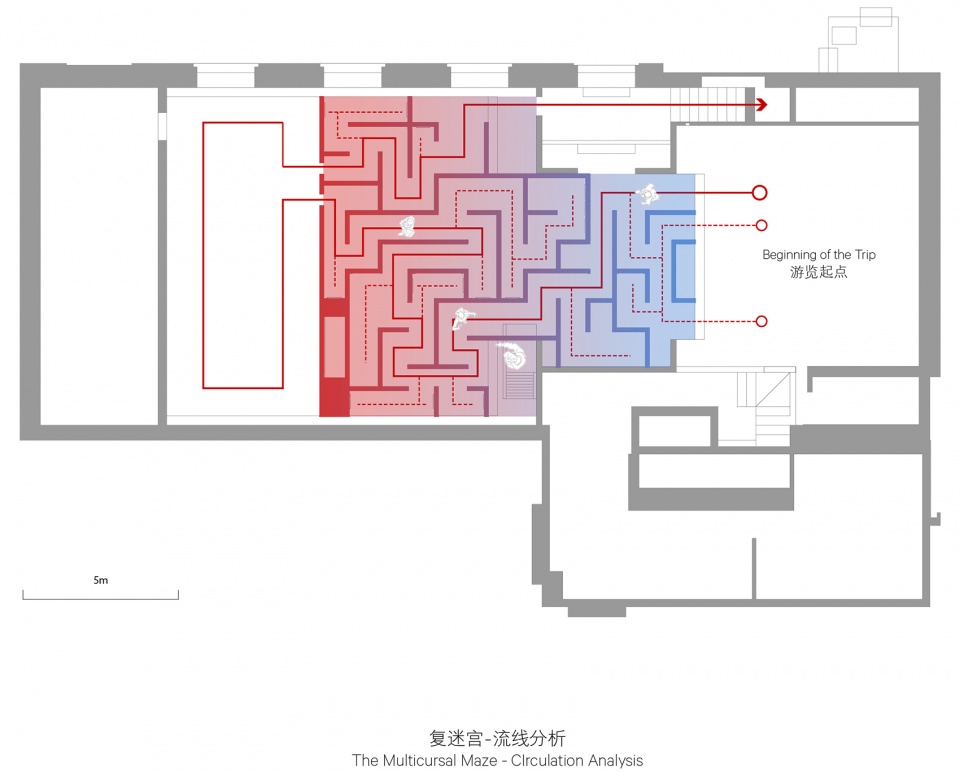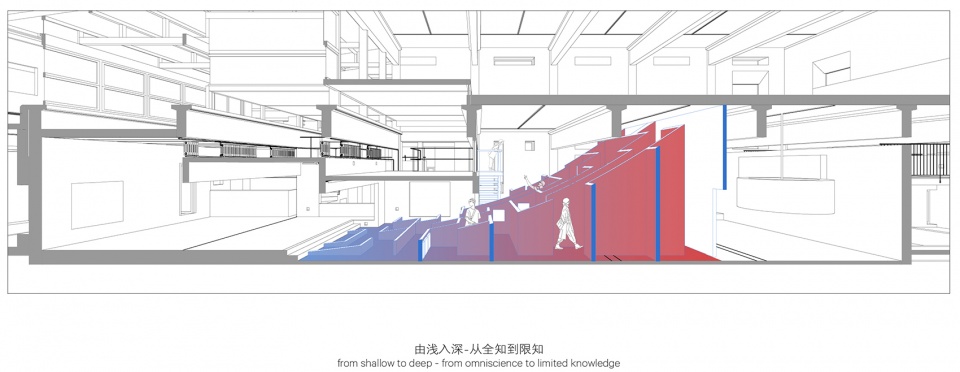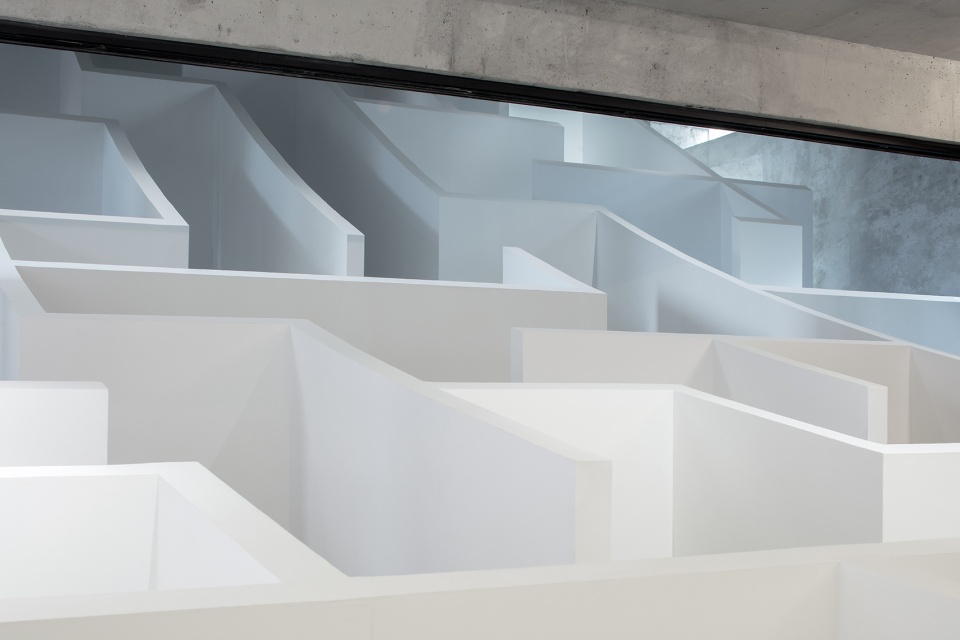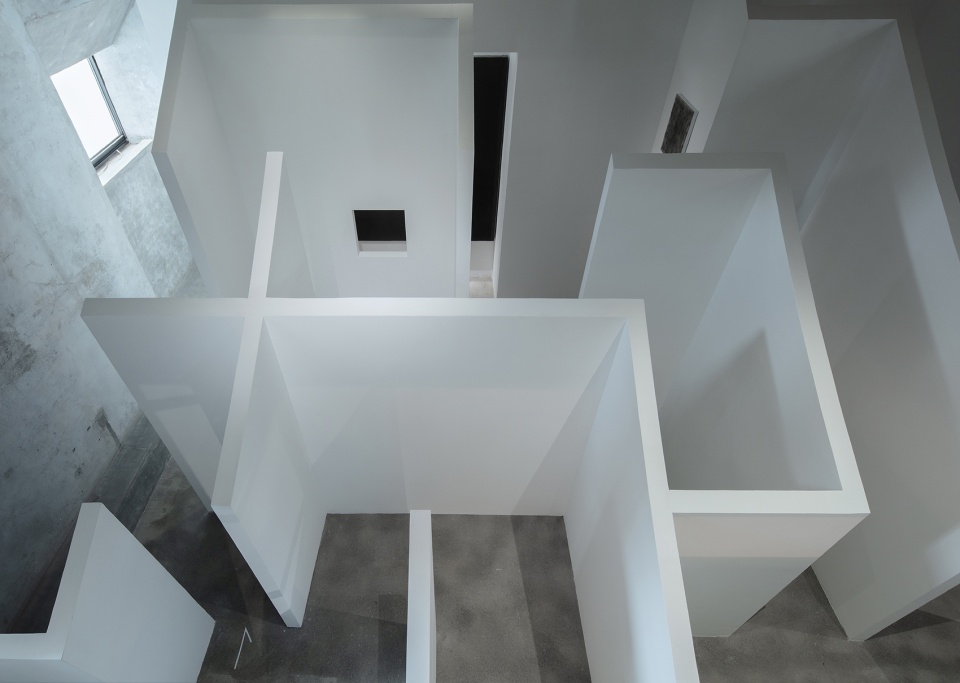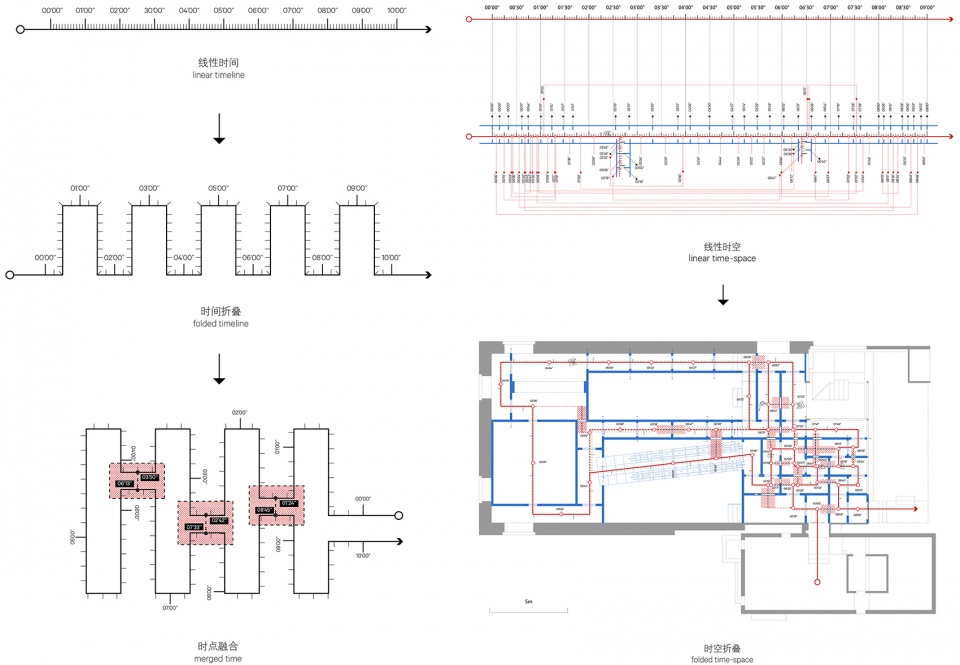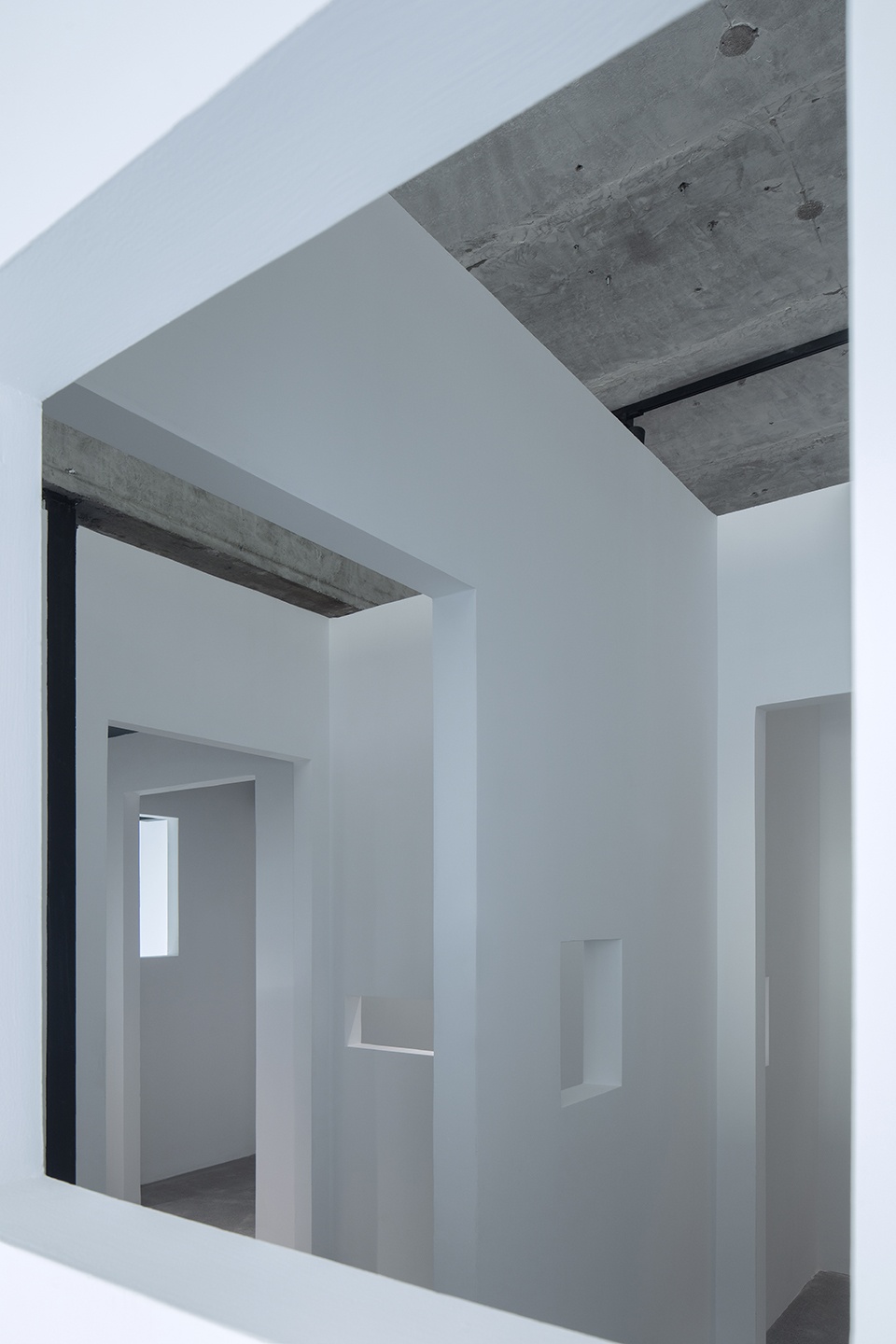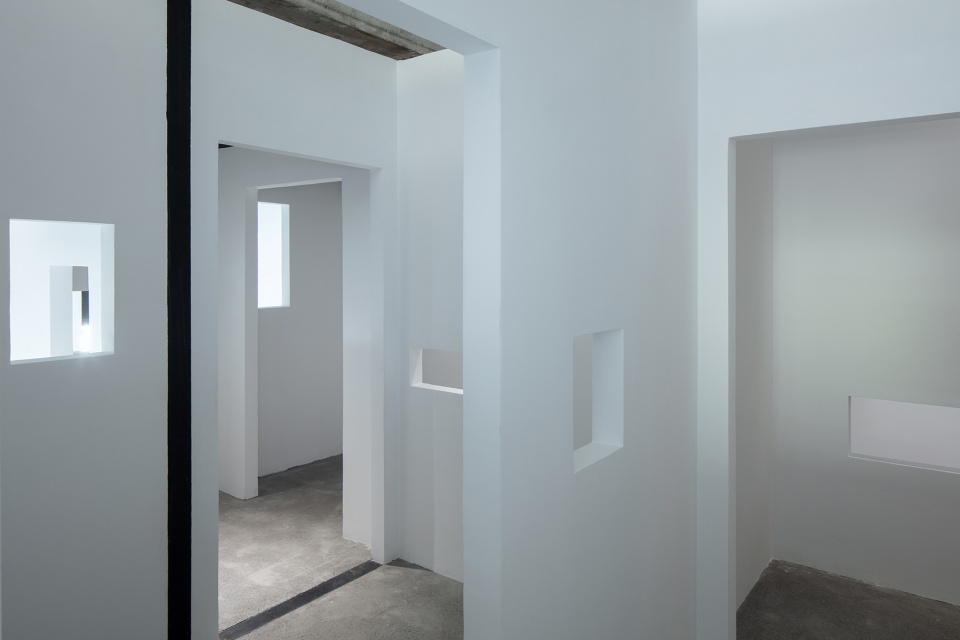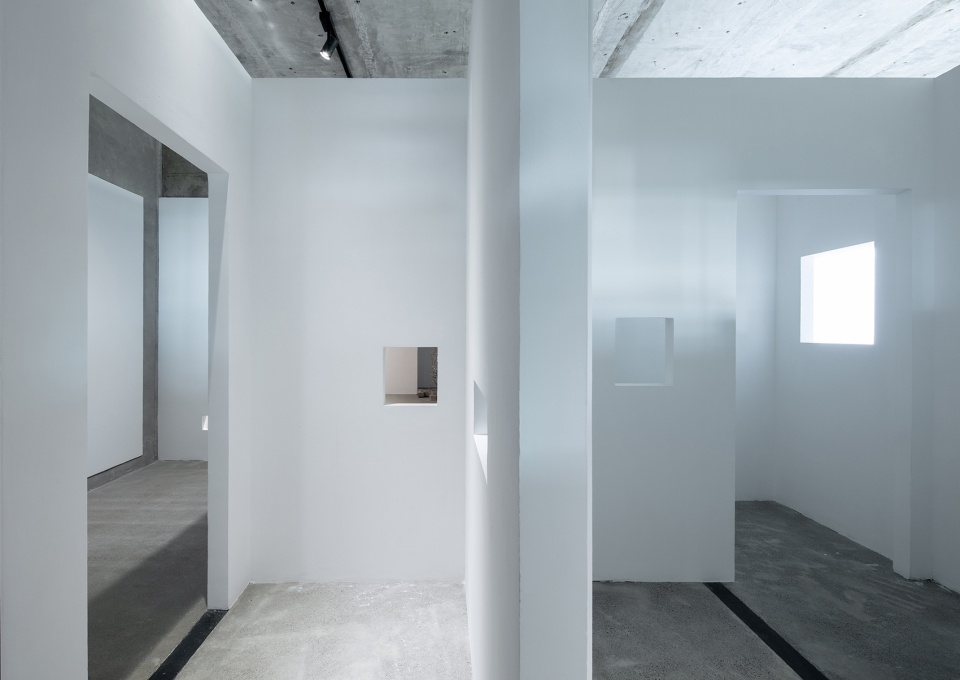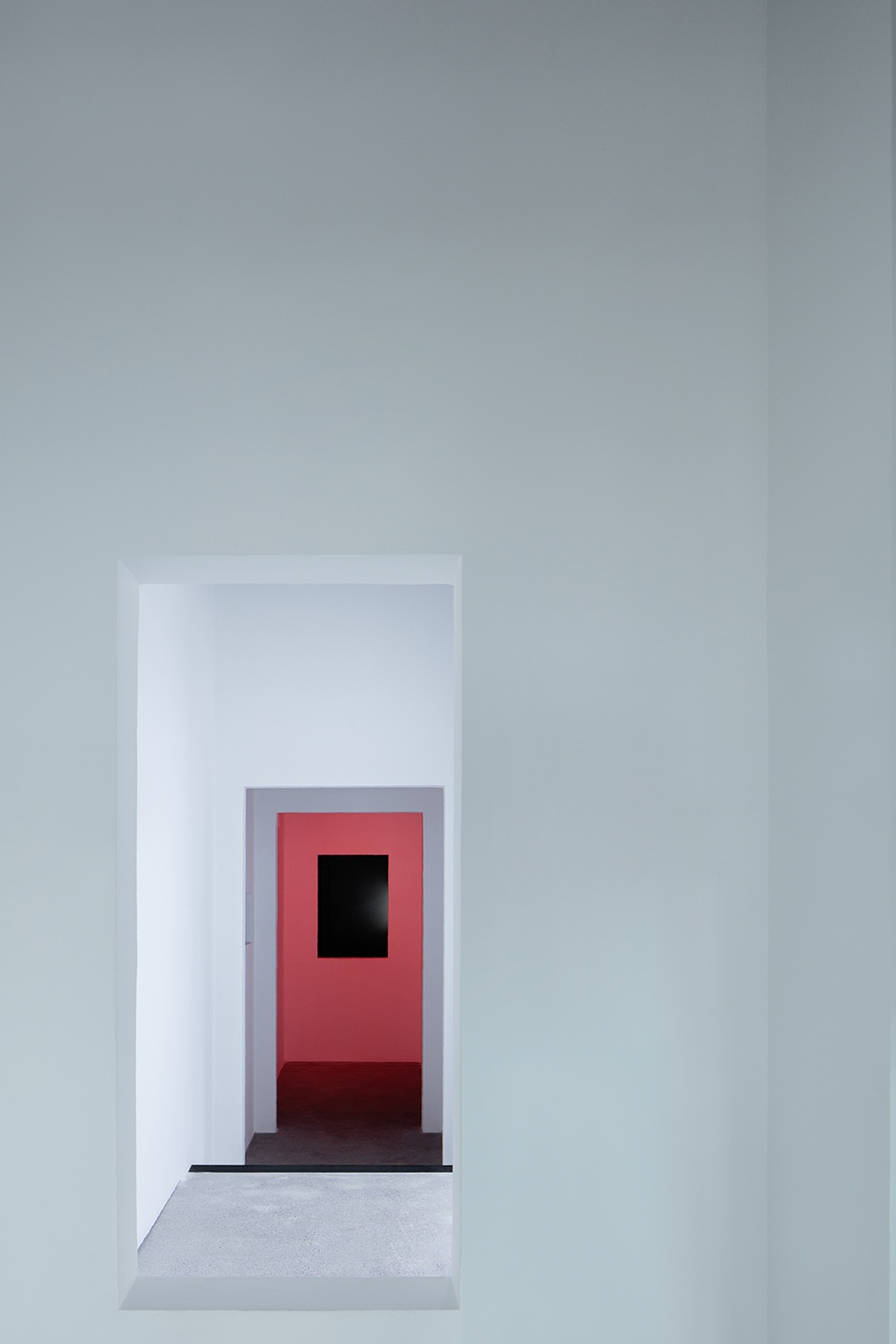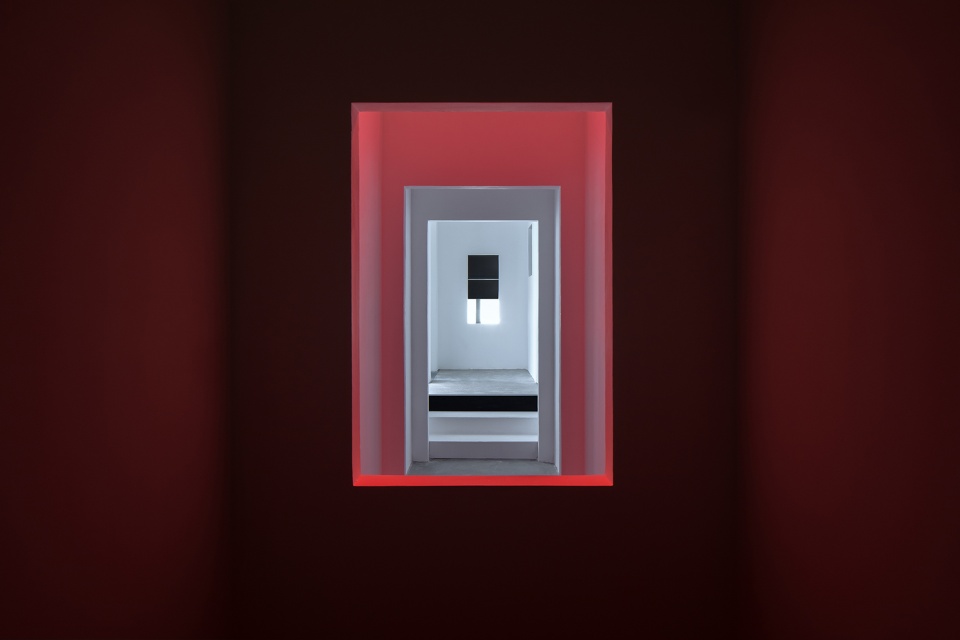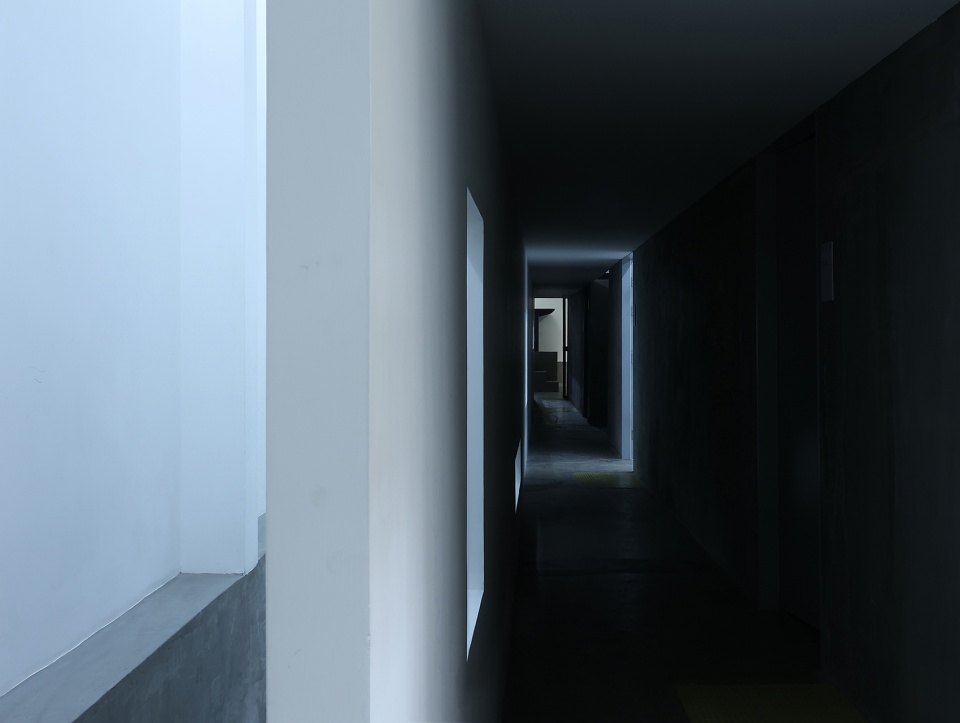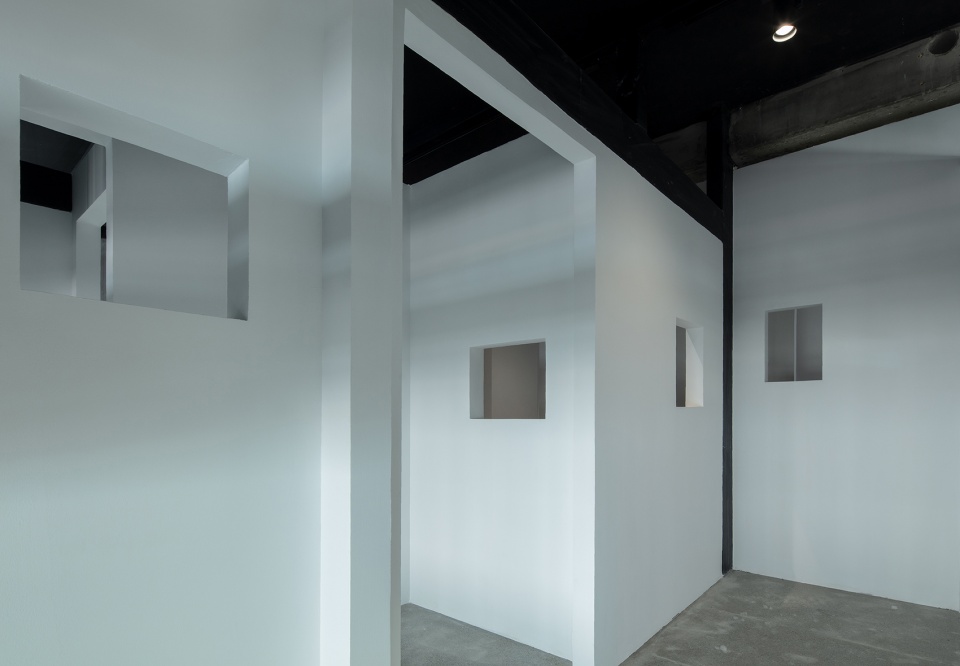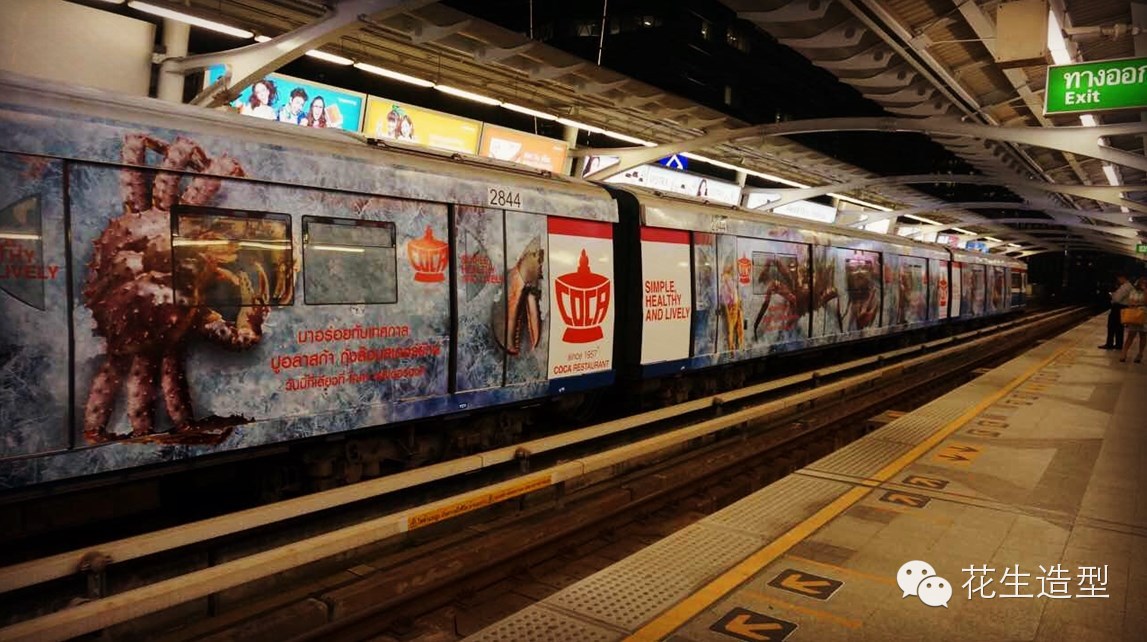

这是一个探索空间叙事的实验性项目。在传统的艺术展览中, 展陈空间常常承担着功能划分、烘托氛围的辅助角色,而在这个以“存在”为题的展陈空间设计中,主角不再仅仅是展出的作品,看展者的“行走”体验被提升放大到一种和作品同等重要的地位,建筑师尝试着以空间为语言去诉说,通过创造一系列浸入式的体验来引导人去感悟“存在”的意义。本设计方案以“迷宫“为原型,在有限的展厅内通过折叠、缠绕、延伸、穿透等手法,搭建起了一个富有层次感、叠加感的均质空间,加上未知的出入口的设置,让人有一种置身于悬念丛生,充满期待的探寻之旅的浸入式体验;与此同时,空间的复杂性和矛盾性会带来一系列空间感知层面的反差和错觉。而错觉所带来的困惑是引发观展者主动思考的动机,它迫使身处其中的人去寻找背后的意义。
▼一层迷宫“感知沉没”整体外观,展览入口,Overall Image of the 1st Floor Maze at the Entrance ©夏至
This experimental project aims to explore the possibilities of spatial narratives. In traditional art exhibitions, space only plays the supporting role of dividing the functional spaces and setting off the atmosphere; while in this exhibition, the protagonists are no longer just the exhibits but the “walking” experience of the visitors, which is promoted and magnified to an equal position of the works on display. By creating a series of immersive experiences, architects use space as a language to guide people to perceive the meaning of “existence”. “Maze” is the prototype of the design: architects create a homogeneous yet multi-layered space within the limited exhibition hall by folding, intertwining, extending, and penetrating the visiting routes, as well as setting unpredictable entrances and exits. As a result, the visiting experience becomes an immersive journey with plenty of expectations and explorations. Meanwhile, the complexity and contradiction of the paces arouse a sense of misconception, which stimulates the visitors in the maze to pursue the hiding meaning on their own.
▼一层迷宫“感知沉没”空间渐变,The Gradual Spatial Change of “The Sunken Perception” on the 1st Floor ©王一迪,袁梦
展陈空间所在的山中天美术馆,是由董豫赣设计的一座有游园体验的建筑。原本的室内空间参差交错,展厅间有多个空间接口和视线连接,本身就带有丰富的空间层次,但因开放性的游览流线贯穿于整个建筑,观展者常常会面临路线的多重选择,这种自由有时会让人迷失,重复出入同一展厅。甚至会让人错过某些展览的内容,分散观展者的注意力,使得整个观展体验被碎片化。这种状况显然与本次展览设计所要追求的“沉浸式体验”和“空间叙事”相悖。因此,展陈建筑师在整体上通过控制每个主要展厅的出入口,将原本复杂的空间序列重新排列,形成了单线、连续的闭环,以实现一种环形叙事 (起点即终点)。在三个主要展厅内,通过“迷宫”及隔墙,重新规划原本开敞或者单一的空间流线,确保唯一的出口和入口,形成局部的单线单相动线。由此,整个观展体验被分为三个章节,并由一条完整的故事线串联起来。
The exhibition is located at the Wind H Art Center designed by Dong Yugan. The building is designed to let the visitors feel as if they are touring a traditional Chinese garden: its interior spaces are interconnected spatially and visually. Visitors are often faced with multiple choices and even a sense of disorientation while switching between different rooms of the building, which may be distracting and make the entire exhibition experience fragmented. Therefore, the original space of the gallery is at odd with the purpose of creating “immersive experience” and “spatial narratives”. By controlling the entrances and exits of each exhibition hall, the architects reorganized the spatial sequence into a continuous closed visiting loop, where the origin also marks the destination. Within three main exhibition halls, the once free or dreary spaces are carefully re-planned into controlled but dramatic one-way visiting routes with one entrance and one exit each. The overall visiting experience is divided into three chaptered connected by one continuous story line.
▼整体流线及叙事 ©相也建筑
Overall Circulation and Story Line
第一章 感知沉没
Chapter 1 The Sunken Perception
置身事外和身处其中所看到的事物对人来说往往是截然不同的存在。这是整个展览中唯一能让人看清全貌的“章节”。建筑师用一个水平上升的曲线将整个“迷宫”横向剖切,使得墙体从外向内逐渐升高 ,将整个错综复杂的截断面直接暴露给身处开敞大厅里的观展者,使其在进入“迷宫”前就能“清晰掌握”自己即将踏上的路径。
Being an insider or outsider would generate entirely distinct perception of the same object or incident. This is the only ‘chapter ’in which the visitor could perceive the appearance of the space. An invisible surface extruded from an ascending exponential curve cut the maze horizontally, making the walls grow taller gradually from the entrance side to the deep inside. As a result, the ‘plan section ’of the maze is directly exposed to the visitors in the entrance lobby, which gives them a clear sense of the path they are about to take before they enter the maze.
▼第一章“感知沉没”轴测图 ©相也建筑
Axonometric of the 1st Chapter, “The Sunken Perception”
而当其逐步深入其中,身边的矮墙渐渐加速生长,当你回过神来已经被高墙所包围,就像从阳光沙滩步入深邃的海底,对空间的感知逐渐沉没。此时你才会意识到当前所处的逼仄环境与最初视觉所看到的有多么不同。而在“复迷宫”所带来的岔路与选择中,在每一个转角背后,你可能会遇到隐藏的展品带来的惊喜,也许是条令人失望的死胡同,又或者是之前经历过多次的另一个转角。历经辗转走进迷宫最深处后,观展者会在某一个转角突然进入一个开敞的“隐藏”展厅,空间尺度的强烈反差将“故事”推向了一种高潮,又或者是平静。
▼第一章“感知沉没”平面及流线 ©相也建筑
Plan and Circulation of the 1st Chapter, “Then Sunken Perception”
▼第一章“感知沉没”剖透视 ©相也建筑
Sectional Perspective of the 1st Chapter, “Then Sunken Perception”
However, while the visitor walking into the maze and getting further, the parapets are growing taller at an accelerating pace. Suddenly, he would find himself surrounded by walls, just like stepping into the deep ocean from the shining beach, the perception of the space is sinking until he totally gets lost. Only at this moment, one could realize how different it is comparing the narrow space he is currently situated to the maze he saw outside. Within each branch road and choice, or behind the corners the “multi-maze” brought about, one might bump into a surprise of hidden artwork, a disappointing dead end, or another corner that has appeared many times before. After a series of turning until reaching the deepest part of the maze, the visitor would enter a hidden open showroom. The great contrast of the spatial scale pushes the “story” to a certain climax, or it just calms down.
▼一层“感知沉没”迷宫肌理,Maze of “The Sunken Perception” on the 1st Floor ©夏至
离开时的路径不同于来路,空间相似,体验则是相反。从进入“迷宫”前自以为的全知到深入其中后的限知与迷失,观展者会从两个视角感知空间上的存在。
The way out is different from the coming path. The space is the same, but the experience is reversed. The visitor would perceive the space from two perspectives, which changes from the omniscience in one’s conceit before entering the maze to a restricted perception and even lost after being inside it.
▼ 一层迷宫“感知沉没”迷宫深处 ©夏至
Deep into the 1st Floor Maze “The Sunken Perception”
在“迷宫”中的一条岔路上,建筑师设置了一个通往二层密室的楼梯,通过这个唯一的楼梯入口,可以在密室中观察到整个迷宫的路线以及其他人的活动,这是唯一可以跳出迷茫,暂时抽离的场所。
The architects put a set of stairs on a branch road of the maze towards a secrete room on the second floor. Through the only access, one could observe the whole path of the maze and people within it. This is the only place, where one could step back from the confusion.
▼一层迷宫“感知沉没”密室俯瞰,Aerial View of the 1st Chapter, “Then Sunken Perception” ©夏至
第二章 时空折叠
Chapter 2 The Folded Space-Time
人并非存在于某一单一的时空中,而是始终存在于过去、未来的交织中,或者说,过去甚至未来都会并置于你的现在。
People do not exist in a single space-time, but always in an intertwined past and future. In other words, the past and even the future are both situated at one’s present.
▼第二章“时空折叠”轴测图 ©相也建筑
Axonometric of the 2nd Chapter, “The Folded Space-Time”
在“第二章”中,建筑师通过一套网格系统,把大展厅拆分成小单元,在充分表现展品的同时,通过隔墙开门设窗等手段,将看展路径溶解其中。单向度、不可逆的路线在网格中穿插迂回而不重叠,线性时间通过空间的折叠而被折叠。看展的路,以及看展的心里期待,在折叠中被拉长、强化;而墙上的小窗,则成为连接过去和未来的时间通道。
In “Chapter 2”, through a set of matrix system, the architects divided the showroom into smaller units. While fully displaying the artworks, the circulation is dissolved into the maze through means of openings on the partition walls, including doors and windows. A unidirectional, irreversible route is weaving back and forth within the matrix but never overlapping with itself. The linear timeline is folded with the folding space. The exhibition circulation is extended as the visitors’ expectations are reinforced. Meanwhile, the small windows on the walls become the “time warp” that connects the future and the past.
▼第二章“时空折叠”示意图,Diagram of the 2nd Chapter, “The Folded Space-Time” ©相也建筑
时间是线性的,但时间的线性状态是以空间的变化为参照的。网格布局下的均质空间,让你在路途中,不知道自己会去向哪里,也不知道自己曾经走过哪里,唯有散布的展品是那个时间的标志。这时候,大小不一,高低错落的小窗本身及其所呈现的“另一个空间”成为了时间流逝的参照系。窗后可能是你未来的必经之路,也可能是你已经走过的路。但正如无论是过去还是未来都只是影影绰绰的记忆或想象一样,小窗这个时间通道让你看到的也只是过去或未来的局部。局部永远是最能调动人窥视欲和悬念感的。当你透过小窗看到其他空间或者与处于其中的人对视的时候,你和你的未来/或者过去,存在于不同的空间,却又存在于同一个瞬间。
Time is linear, but its linear attribute is taking the changes of space as the reference. It is hard for one to tell where to go and where he has been in these homogeneous space units under the matrix layout, in which only the exhibits are the symbols of those moments. Under this circumstance, these randomly placed small windows with different sizes and “other space” they are framing become the signal of passing time. The space behind the window might be the way one must step on in the future, or the place he has already been. Just as both the past and the future are only fragmented memories or imaginations, through the window you see only parts of the past or future. It is always the parts that could stimulate people’s desire of peep, as well as the sense of suspense. When you see other space or watch each other with another person through the window, you and your future/past exist in different space, but at the same moment.
▼二层迷宫“时空折叠”小窗透视 ©夏至
Framed View of the 2nd Chapter, “The Folded Space-Time”
▼二层迷宫“时空折叠”空间透视,Perspective of the 2nd Floor Maze, “The Folded Space-Time” ©夏至
在“第二章”迷宫的单线单相主动线之外,建筑师在“故事”的前半段和后半段分别设置了一条岔路,它们的终点都是死路。这两条死路的尽头被拼接在一起。在这里,行走流线被阻隔,而视线却通过小窗被连结。同时,顶部打下的红光成为这个空间的标志,光线在这里弥散开来在两个时间渗透。身处两个时空中的人,一个刚刚开始他的“旅程”,一个却已经到了尾声。而他们却在同一刻望着对方,分享着同样的被红色晕染的氛围。
Beyond the single unidirectional main circulation of the maze, the architects set up two branch roads at the first half and the second half of the “story” respectively. Both branches have dead ends, laid against each other. In this place, the walking ways are blocked, but the visual connections are built by a window. Meanwhile, the red light that drop in become the symbol of this space. The light diffuses here, permeating into two “times”. People in the two space-time could talk to each other, but one has just started his journey, while the other one is approaching the ending. However, they are staring at each other at the same moment, sharing the same atmosphere in red.
▼二层迷宫“时空折叠”岔路 ©夏至
The Fork of “The Folded Space-Time” on the 2nd Floor
▼二层迷宫“时空折叠”岔路尽头,The Cul-de-sac of the “Folded Space-Time” ©夏至
第三章 视觉伸缩
Chapter 3 The Stretching Vision
未来的路总是漫长,而过去的回忆又总是短暂。
Long journey awaits in the future, yet the past contracts in memories.
▼ 第三章“视觉伸缩”轴测图 ©相也建筑
Axonometric of the 3rd Chapter, “The Stretching Vision”
“第三章”的展览空间是一个狭长的走廊,建筑师将原本狭长的空间进行了倾斜的切割,切割的长廊形成折返的流线,它们并置存在,却在高度、光线、明暗等方面形成对比,创造了视觉透视上的错觉:看展者在进入前展望,逐渐变窄的走廊在感官上延长了路径的长度;而在经过后回望,逐渐变宽的走廊在感官上缩短了来路的长度。建筑师用空间的方式,表现了同一时间长度在来和去时的不同心理体验。
▼第三章“视觉伸缩”透视分析 ©相也建筑
Perspective Analysis of the 3rd Chapter, “The Stretching Vision”
The exhibition space in the “3rd chapter” is a long and narrow corridor, which is split into two with a wall at a slanted angle. These two even narrower retractable corridors lay against each other, but have large contrast in space height, light and shadow, which generates an illusion on visual perspective: before stepping into the corridor and looking forward, the corridor getting narrower lengthens the path in the visitor’s vision, while after passing it and look back, the widening corridor looks shorter than it is. The architects presented the different psychological experience of coming and going at the same time length through adjusting the space.
▼第三章 “视觉伸缩”入口,Entrance of the 3rd Chapter, “The Stretching Vision” ©王一迪,袁梦
在三个章节中,建筑师通过把控一系列连续空间的叙事逻辑和情绪节奏,创造了与14位艺术家的作品相得益彰的沉浸体验。展览空间在充当艺术品的容器的同时,其本身通过“迷宫”所塑造的空间体验也成为一件特别的展品,从另一维度表达了建筑师对于“存在”这一展览主题的理解。
展览“存在”于2021年3月18开幕,由山中天艺术中心主办,十点睡觉艺术空间协办。此次展览为山中天艺术中心本年度的首展,由当代艺术批评家、独立策展人、女性艺术研究者廖雯策展,呈现14位艺术家在疫情隔离期间的创作。本次展览采用“全封闭”的展场设计,令每一个艺术家的空间都具有独立性,造就了一种被迫“隔离”的状态,使观众打破了惯常的观展方式,获得独特的体验感,更多地参与和融入,从而引发对“存在”更广泛意义上的关注。
In the three “chapters”, by manipulating the rhythm of narratives and emotions in a sequence of space, the architects created an immersive experience that complements the work of 14 artists. While the exhibition space serves as the container of artworks, it is also an unique exhibit in the form of “maze,” which expresses the architects; understanding of “existence” from another dimension.
The exhibition “Existence” was unveiled on March 18th, 2021, hosted by Wind H Art Center, and assisted by Click Ten Company, marking the first exhibition of the year. Curated by contemporary art critic, independent curator, and female art researcher Liao Wen, the exhibition presents the works of 14 artists during the COVID-19 quarantine. The exhibition halls are “fully enclosed” independent spaces for each artist, creating a state of “forced isolation”. The unique exhibition experience breaks the traditional way of visiting and encourages the audience to actively explore the space and engage in the exhibition, thus stimulating and attracting a broader attention to the topic of “Existence”.
▼展览实景:特别的空间体验,Exhibition: special space experience ©夏至
设计时间:2021.01-2021.03
展览“存在”时间:2021.03.18 -2021.05.09
展览设计地点:北京市 朝阳区 山中天艺术中心
主办机构:山中天艺术中心
协办单位:十点睡觉艺术空间
设计单位:相也建筑
项目负责人:王闻
主创设计师:王闻,秦铭煊
空间设计团队:孙鹏程,费扬,孙继超
文字整理:秦铭煊
摄影:夏至,王一迪、袁梦
相也建筑联系邮箱:wenw25@163.com
Design Period: 2021.01-2021.03
Exhibition Period: 2021.03.18-2021.05.09
Project Location: Wind H Art Center, Chaoyang District, Beijing
Host: Wind H Art Center
Assistance: Click Ten Company
Architect: Mutuality Architects
Project Manager: Wen Wang
Lead Architects: Wen Wang, Mingxuan Qin
Design Team: Pengcheng Sun, Yang Fei, Adam Jichao Sun
Editor: Mingxuan Qin
Photographer: Xia Zhi, Yidi Wang, Meng Yuan
Mutuality Architects contact email: wenw25@163.com








